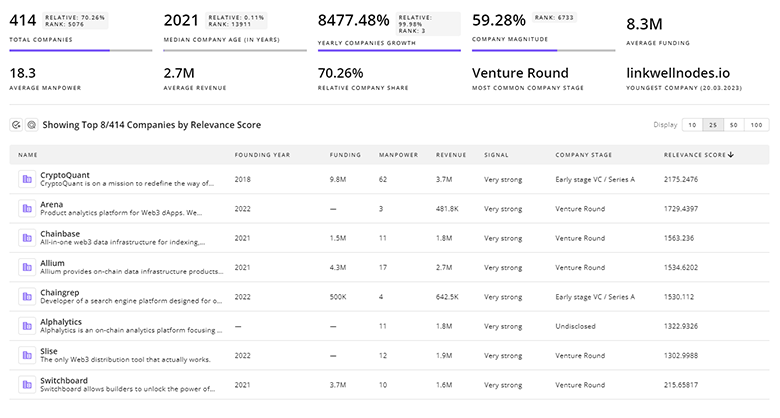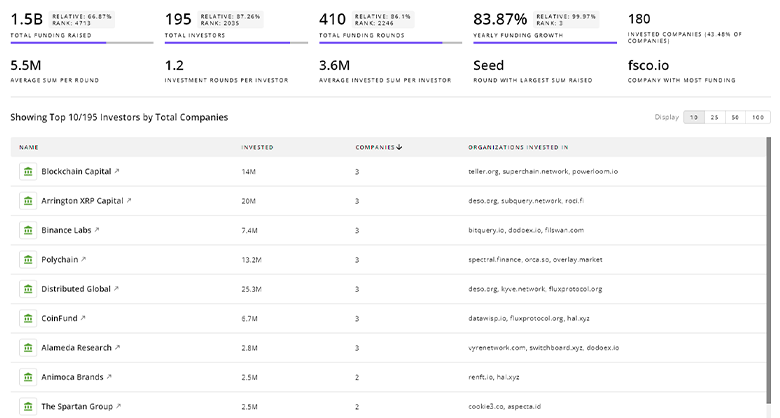
Engineering Simulation Report
: Analysis on the Market, Trends, and TechnologiesThe engineering simulation market reached approximately USD 11.0 billion in 2024 and the internal data projects it to reach USD 24.06 billion by 2031 at an 11.8% CAGR, signalling sustained commercial expansion and strong demand for cloud and AI-enabled capabilities.
This article was last updated 35 days ago. If you find any info is missing, let us know!
Topic Dominance Index of Engineering Simulation
The Dominance Index of Engineering Simulation looks at the evolution of the sector through a combination of multiple data sources. We analyze the distribution of news articles that mention Engineering Simulation, the timeline of newly founded companies working in this sector, and the share of voice within the global search data
Key Activities and Applications
- Simulation-driven design and verification: Teams use simulation early to reduce physical prototyping, shorten iteration cycles, and meet stricter safety and emissions rules in regulated industries.
- Cloud-native, on-demand CAE: Organizations run CFD, FEA, thermal, and electromagnetics workloads in the cloud to scale compute elastically and support distributed engineering teams.
- Digital twins and lifecycle simulation: Virtual replicas ingest live sensor data and enable predictive maintenance, operational what-if testing, and factory commissioning workflows.
- Real-time emulation and HIL/SIL testing: Power-electronics, inverter validation, and grid studies increasingly rely on sub-millisecond synchronization and hardware-in-the-loop rigs to de-risk commissioning.
- AI-assisted workflow automation: Automated geometry cleanup, smart meshing, failure detection during runs, and natural-language result interpretation reduce the specialist burden and compress engineer cycles.
- Reduced-order and surrogate modeling for high-volume testing: Surrogates cut compute cost for parameter sweeps and design spaces used in autonomy, EV, and aero problems.
- Virtual commissioning and manufacturing process simulation: Factories validate PLC logic and robotic workcells virtually to shorten commissioning by multiple weeks in complex lines.
Emergent Trends and Core Insights
- Platform consolidation and cloud adoption accelerate: Market dynamics favour integrated, cloud-first platforms that combine CAD, multi-physics solvers, and data pipelines; vendors that provide end-to-end toolchains capture larger wallet share.
- AI reduces turnaround time and operator skill burden: AI/ML enables autonomous preprocessing, failure recovery, and postprocessing explanation, with reported workflow time reductions of 20–30% in practical deployments SimScale blog and DigitalEngineering247.
- Surrogate and ROM adoption scales testbeds: Deep-learning surrogates deliver orders-of-magnitude runtime improvements for repeated evaluations, enabling coverage-driven verification for autonomy and product families.
- Real-time digital twins move from R&D to operations: Industries operating critical assets—energy, aerospace, manufacturing—use live twins for predictive maintenance and rapid scenario testing, which reduces downtime and commissioning risk.
- Democratization through focused apps and open source: Lower-cost, domain-focused offerings and open-source engine integrations expand simulation use beyond specialist CAE groups into SMEs and education.
- Industry vertical specialization increases: Automotive, aerospace, power systems, and additive manufacturing require tailored workflows (sensor stacks, multi-physics couplers, process simulation), creating niches for vertical specialists and Automotive Simulation Market report.
Technologies and Methodologies
- Finite Element Analysis (FEA) and advanced meshing: Continued solver and mesh automation innovation reduces setup time for structural and thermal problems Finite Element Analysis Market report.
- Computational Fluid Dynamics (CFD) and particle-based methods: Faster solvers and GPU acceleration expand CFD use into thermal management, HVAC, and small-scale multiphase problems.
- Reduced-Order Modeling and ML surrogates: Physics-aware ML and ROMs supply rapid approximations for optimization loops and Monte Carlo testing SimR analysis.
- Cloud HPC and SaaS CAE: Browser-based platforms and usage-based licensing enable distributed teams to run high-fidelity simulations without on-premise HPC SimScale and MarketResearchFuture report.
- HIL/SIL/PiL frameworks for real-time validation: Deterministic, low-latency stacks validate controllers and power electronics before hardware handover Opal-RT article.
- Integrated CAD-to-CAE workflows and MBSE: Isogeometric analysis and stronger CAD integration remove data translation friction and enable model-based systems engineering.
- AR/VR visualization for collaborative reviews: Immersive visualization tied to simulation outputs supports faster cross-discipline decisions on the shop floor and in test labs Machineering trends piece.
Engineering Simulation Funding
A total of 69 Engineering Simulation companies have received funding.
Overall, Engineering Simulation companies have raised $1.9B.
Companies within the Engineering Simulation domain have secured capital from 248 funding rounds.
The chart shows the funding trendline of Engineering Simulation companies over the last 5 years
Engineering Simulation Companies
DivergenceAI — DivergenceAI focuses on AI-driven automation across the CAE pipeline: automatic preprocessing and smart meshing, autonomous run-monitoring with self-healing retries, and natural-language postprocessing that surfaces insights to non-specialists. The product targets engineering teams that need to shorten set up and troubleshooting time while keeping higher-fidelity solvers in the loop. This approach directly maps to the field's need for workflow automation and democratized CAE.
Nefario — Nefario develops cloud-native engines and scenario generation for autonomous vehicle simulation, including large-scale road and traffic reproduction, AI-trained vehicle models, and a billion-simulation cloud engine for exhaustive testing. The stack addresses two industry needs: massive scenario coverage for autonomy validation and compute efficiency for continuous regression testing. Nefario's products suit OEMs and AV stack developers focused on safety verification at scale.
CENOS Simulation Software — CENOS assembles open-source solvers into focused, affordable apps for targeted domains such as induction heating and antenna design, lowering the entry price for SMEs and labs. The product strategy delivers rapid time to value by removing unnecessary generality and integrating proven academic engines under a single interface. This model supports the market trend toward democratized, app-style simulation.
Novus Nexus, Inc. — Novus Nexus builds abstract-modeling tools that embed CFD problem definitions independent of geometry, enabling repeatable, expert-defined processes to be used by less-experienced staff. The company's approach targets organizations that want to scale CFD best practices while protecting solver fidelity, reducing dependence on scarce CAE experts. That trade space matches demand for automated preprocessing and process capture in enterprise CAE.
SimCraft — SimCraft delivers high-fidelity motion simulation platforms that combine real-time physics engines with precision hardware for driver and pilot training. The company prioritizes low latency and physiological realism, serving professional training, motorsport, and defense customers that require highly accurate closed-loop dynamics. SimCraft exemplifies the marketplace for specialized, real-time simulation hardware/software integration.
Uncover actionable market insights on 703 companies driving Engineering Simulation with TrendFeedr's Companies tool.

703 Engineering Simulation Companies
Discover Engineering Simulation Companies, their Funding, Manpower, Revenues, Stages, and much more
Engineering Simulation Investors
Get ahead with your investment strategy with insights into 324 Engineering Simulation investors. TrendFeedr’s investors tool is your go-to source for comprehensive analysis of investment activities and financial trends. The tool is tailored for navigating the investment world, offering insights for successful market positioning and partnerships within Engineering Simulation.

324 Engineering Simulation Investors
Discover Engineering Simulation Investors, Funding Rounds, Invested Amounts, and Funding Growth
Engineering Simulation News
TrendFeedr’s News feature offers access to 1.4K news articles on Engineering Simulation. The tool provides up-to-date news on trends, technologies, and companies, enabling effective trend and sentiment tracking.

1.4K Engineering Simulation News Articles
Discover Latest Engineering Simulation Articles, News Magnitude, Publication Propagation, Yearly Growth, and Strongest Publications
Executive Summary
Engineering simulation now drives decision making across design, validation, and operations by compressing iteration loops, shifting verification left, and enabling predictive operations. Market data point to sustained double-digit growth for CAE and adjacent simulation segments; that growth stems from cloud economics, AI automation, and expanding use cases such as digital twins and autonomy testing. For vendors, the two pragmatic strategic choices stand out: integrate into broader cloud-native platforms to capture lifecycle spend or specialize deeply in vertical workflows where domain knowledge yields defensible margins. For engineering organizations, prioritize automation of repetitive CAE tasks, invest in ROM and surrogate capabilities to widen test coverage, and adopt cloud execution models that align compute cost with usage patterns to scale simulation without equivalent capital outlay.
Have expertise in trends or technology? Your input can enrich our content — consider collaborating with us!












